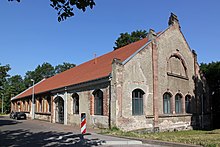Hereditary Grand Duke Friedrich Barracks (Koblenz)
|
|
|||
|---|---|---|---|
| today | overbuilt | ||
| local community | Koblenz | ||
| Coordinates : | 50 ° 21 ' N , 7 ° 35' E | ||
| Opened | 1903 | ||
| Old barracks names | |||
| 1923-1929 | Caserne Turenne |
|
|
| Formerly stationed units | |||
| Infantry Regiment No. 68 |
|
||
|
Location of the Hereditary Grand Duke Friedrich Barracks in Rhineland-Palatinate |
|||
The Erbgroßherzog-Friedrich-Kaserne was a military property in Koblenz . The barracks , completed in 1903 and demolished in the 1980s, was located in the Karthaus district between the Grand Duke Fort Konstantin and the fortress of Emperor Alexander . Only a parade hall and two residential buildings have survived. The barracks was named after the then commanding general of the VIII Army Corps , Lieutenant General Hereditary Grand Duke Friedrich von Baden . She was with the II. Battalion of the Kgl. Prussian Infantry Regiment No. 68 occupied.
history
The Grand Duke Fort Konstantin, built at the beginning of the 19th century as part of the construction of the Koblenz Fortress , was unsuitable for accommodating soldiers. As early as 1860, on the upstream plateau, the “Marsfeld”, the construction of barracks barracks, which could be quickly removed in the event of war, including a parade ground. A little later, the barracks on the Spitzberg were built in the immediate vicinity .
After the parts of the Koblenz fortress on the left bank of the Rhine including the Grand Duke Konstantin Fort were abandoned in 1890, the Hereditary Grand Duke Friedrich barracks were built on the Marsfeld in 1901–1903. Previously, some units were still housed in the former fortress casemates. The facility, designed in neo-renaissance forms , consisted of two team houses for two companies each , a farm building , two latrines (courtyard abortions), family house I for married NCOs and civil servants, as well as a parade hall. A second parade hall in front of the Grand Duke Konstantin Fort was for the III, who was housed in the Spitzberg barracks opposite. Battalion of the 68th Infantry Regiment.
After the First World War, as part of the Allied occupation of the Rhineland , French occupation troops moved into the barracks in 1923 and named them "Caserne Turenne". After the French left in 1929, the crew blocks stood empty for a while until they were converted into apartments. The parade hall of the former 2nd Battalion of Infantry Regiment No. 68 was badly damaged in air raids during World War II and then demolished. The also damaged crew house II was rebuilt reduced. Until 1961, residential buildings for bombed-out families were built on the parade ground.
The two blocks of flats served as apartments until the 1980s. The farm building was used by the technical relief organization as a warehouse and base. Efforts by private investors to demolish the two large buildings and to build a housing estate at this point initially failed because the entire ensemble had been placed under monument protection. Without this protection having been lifted, the two team houses and the family house fell victim to the pickaxe in 1982. Likewise, in 2000 the farm building and the courtyard abortion No. II were demolished against the resistance of the population.
Today the former parade hall of the III. Battalion of Infantry Regiment No. 68 and serves as a sports hall . In the curve of Simmerner Straße are the two family houses II and III from 1912 to 1914, which were used by the entire Infantry Regiment No. 68, as well as the officers' lodgings. The site was completely built on by a new housing estate in the 1990s.
Two portal ensembles to the basement rooms could be saved. They were integrated into a building in Münzstrasse in Koblenz's old town during a renovation .
Monument protection
The parade hall in front of the former Hereditary Grand Duke Friedrich Barracks is a protected cultural monument according to the Monument Protection Act (DSchG) and entered in the list of monuments of the state of Rhineland-Palatinate . It is located in Koblenz-Karthause at Fort Konstantin 40 .
The former parade hall has been part of the Upper Middle Rhine Valley UNESCO World Heritage Site since 2002 .
literature
- Rüdiger Wischemann: The Koblenz Fortress. From the Roman fort and Prussia's strongest fortress to the largest garrison of the Bundeswehr. Rhenania, Koblenz 1978.
- Friedrich Bertkau: History of the 6th Rhenish Infantry Regiment No. 68. Groos, Coblenz 1908.
- Manfred Böckling: "This new accommodation was a major step forward". The Hereditary Grand Duke Friedrich Barracks in front of Fort Konstantin. - In: Fort Constantine. Historic place with a future. For the 20th anniversary of the PRO KONSTANTIN association (1993–2013). Ed .: PRO KONSTANTIN e. V. Overall editing: Sebastian Gleixner. Koblenz: Garwain Verlag 2013. pp. 67–82. ISBN 978-3-936436-24-2 .
- Ulrike Weber (edit.): Cultural monuments in Rhineland-Palatinate. Monument topography Federal Republic of Germany. Volume 3.3: City of Koblenz. Districts. Werner, Worms 2013, ISBN 978-3-88462-345-9 .
Web links
- Ortwin Reich: From Beatusberg to Fort Konstantin (PDF; 4.5 MB)
- Series of images from the database of the LAD Rhineland-Palatinate
Individual evidence
- ↑ According to a report by the Rhein-Zeitung, the State Monuments Office obtained a four-digit fine against the perpetrator.
- ^ General Directorate for Cultural Heritage Rhineland-Palatinate (ed.): Informational directory of cultural monuments - district-free city of Koblenz. Mainz 2020, p. 23 (PDF; 6.5 MB).



